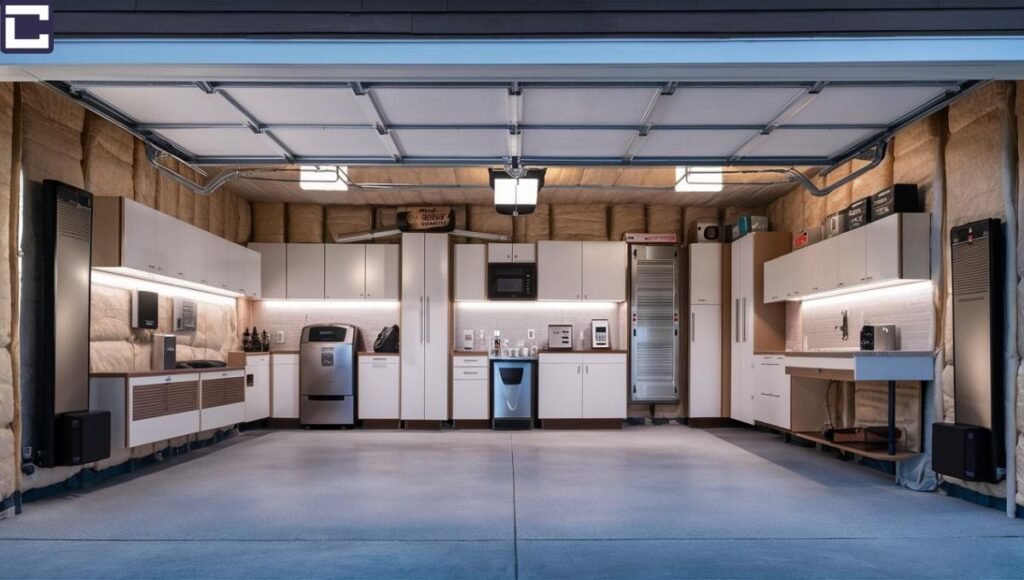Heats your garage efficiently without breaking the bank is a top priority for many homeowners in today’s world, where every penny counts and environmental consciousness is on the rise. Whether you’re looking to create a cozy workspace, protect your vehicles from the cold, or simply make your garage a more comfortable space, there are plenty of simple and effective techniques you can employ to achieve warmth without spending a dime.
In this comprehensive guide, we’ll explore innovative methods for heating your garage for free, covering everything from harnessing solar power to recycling waste heat and incorporating energy-efficient appliances.
Understanding the Heat your Garage for free
Before diving into the specifics of how to heat your garage for free, it’s essential to understand why it matters. Heating your garage without incurring additional costs not only saves you money but also reduces your carbon footprint and contributes to a more sustainable future. By utilizing renewable energy sources and maximizing the efficiency of existing systems, you can achieve warmth and comfort without compromising on environmental responsibility.
Harnessing Solar Power
One of the most abundant and readily available sources of free energy is the sun. By harnessing solar power, you can heat your garage using nothing but sunlight, reducing your reliance on traditional heating methods and lowering your utility bills in the process. Installing solar panels on your garage roof or property allows you to capture sunlight and convert it into usable heat through photovoltaic or solar thermal systems.
How to Install Solar Panels for Garage Heating
- Start by assessing your garage’s sun exposure to determine the optimal placement for solar panels.
- Choose high-quality, durable solar panels that are suitable for your climate and energy needs.
- Follow manufacturer instructions or consult with a professional installer to ensure proper installation and alignment for maximum sunlight absorption.
- Consider integrating solar batteries or grid-tied systems to store excess energy and offset nighttime heating requirements.
Recycle Waste Heat
Another ingenious way to heat your garage for free is by recycling waste heat generated by household appliances. Appliances like dryers, water heaters, and ovens produce heat as a byproduct of their operation, which can be captured and redirected into your garage space to supplement heating needs. By strategically positioning your appliances and implementing simple ducting or ventilation systems, you can harness this waste heat and put it to good use.
DIY Techniques for Recycling Waste Heat
- Install ductwork or ventilation systems to channel warm air from appliances into the garage.
- Use heat exchangers or heat recovery ventilators to capture and transfer heat energy efficiently.
- Seal gaps and cracks in ductwork to prevent heat loss and ensure optimal heating performance.
- Monitor and adjust ventilation settings to balance heating requirements with indoor air quality and humidity levels.
DIY Insulation Techniques

Proper insulation is key to retaining heat and preventing energy loss in your garage. By insulating walls, ceilings, and doors, you can create a barrier against outdoor temperatures and maintain a comfortable indoor climate year-round. Fortunately, there are plenty of affordable and accessible materials you can use to insulate your garage effectively, from foam boards and weatherstripping to reflective barriers and thermal blankets.
Cost-Effective Insulation Materials
- Foam boards: Lightweight and easy to install, foam boards provide excellent thermal insulation for walls and ceilings.
- Weatherstripping: Seal gaps around doors and windows to prevent drafts and air leaks, improving overall insulation efficiency.
- Reflective barriers: Reflective insulation materials, such as foil-faced bubble wrap or radiant barriers, reflect heat back into the garage, reducing heat loss through conduction.
Utilizing Natural Ventilation
Strategic ventilation is essential for regulating temperature and humidity levels in your garage without relying on external heating sources. By harnessing natural airflow and ventilation patterns, you can expel excess heat during warmer months and retain warmth during colder seasons, maintaining a comfortable and energy-efficient environment year-round.
Tips for Natural Ventilation
- Install windows or vents to facilitate cross-ventilation and promote airflow throughout the garage.
- Use exhaust fans or roof vents to remove hot air and moisture buildup, especially in humid climates.
- Consider adding passive ventilation systems, such as ridge vents or gable vents, to enhance natural airflow and reduce the need for mechanical cooling.
Incorporating Thermal Mass
Thermal mass refers to materials with high heat capacity, such as concrete, stone, or water, that can absorb and store heat energy for gradual release. By incorporating thermal mass elements into your garage design, you can stabilize temperature fluctuations and improve heating efficiency without relying on external heat sources.
Creative Uses of Thermal Mass
- Install concrete or stone flooring to absorb and retain heat during the day, releasing it slowly at night to maintain a comfortable temperature.
- Use water containers or barrels as thermal mass reservoirs, strategically placing them in sunny areas to absorb solar heat and distribute it throughout the garage space.
- Consider building interior walls or partitions using thermal mass materials to create a thermal buffer zone and enhance overall heating performance.
Embracing Energy-Efficient Appliances

Replacing old, inefficient appliances with energy-efficient models is another effective way to reduce heating costs and environmental impact in your garage. Energy-efficient heaters, light fixtures, and electronics are designed to minimize energy consumption while delivering optimal performance, helping you save money on utility bills and reduce your carbon footprint.
Benefits of Energy-Efficient Appliances
- Lower energy bills: Energy-efficient appliances consume less electricity, resulting in lower monthly utility bills and long-term cost savings.
- Environmental sustainability: By reducing energy consumption, energy-efficient appliances help mitigate greenhouse gas emissions and minimize environmental impact.
- Enhanced performance: Energy-efficient heaters and electronics offer advanced features and functionality, ensuring reliable performance and optimal comfort in your garage space.
Conclusion:
Heating your garage for free is not only achievable but also practical and environmentally responsible. By harnessing renewable energy sources, recycling waste heat, and optimizing insulation and ventilation systems, you can create a comfortable and energy-efficient space without breaking the bank. Whether you’re a DIY enthusiast or prefer to enlist professional help, there are plenty of simple and effective techniques you can employ to heat your garage for free and enjoy year-round comfort and savings. So why wait? Start implementing these innovative heating solutions today and reap the rewards of a warm and inviting garage space without spending a dime.
Frequently Asked Questions (FAQs):
How can I heat my garage for free using solar power?
Install solar panels on your garage roof to capture sunlight and convert it into heat. Ensure proper installation and consider using solar batteries to store excess energy for nighttime use.
What are some DIY techniques for recycling waste heat in my garage?
Install ductwork or ventilation systems to channel warm air from household appliances like dryers and ovens into the garage. Use heat exchangers to capture and transfer this heat efficiently.
What are the best cost-effective insulation materials for my garage?
Use foam boards for walls and ceilings, weatherstripping for doors and windows, and reflective barriers like foil-faced bubble wrap to retain heat and improve insulation efficiency.
How can natural ventilation help in heating my garage?
Install windows or vents for cross-ventilation, use exhaust fans to remove excess heat and moisture, and add passive ventilation systems like ridge vents to enhance airflow and maintain comfortable temperatures.
What are the benefits of using energy-efficient appliances in my garage?
Energy-efficient appliances lower energy bills, reduce environmental impact by consuming less electricity and offer enhanced performance with advanced features for optimal comfort.













